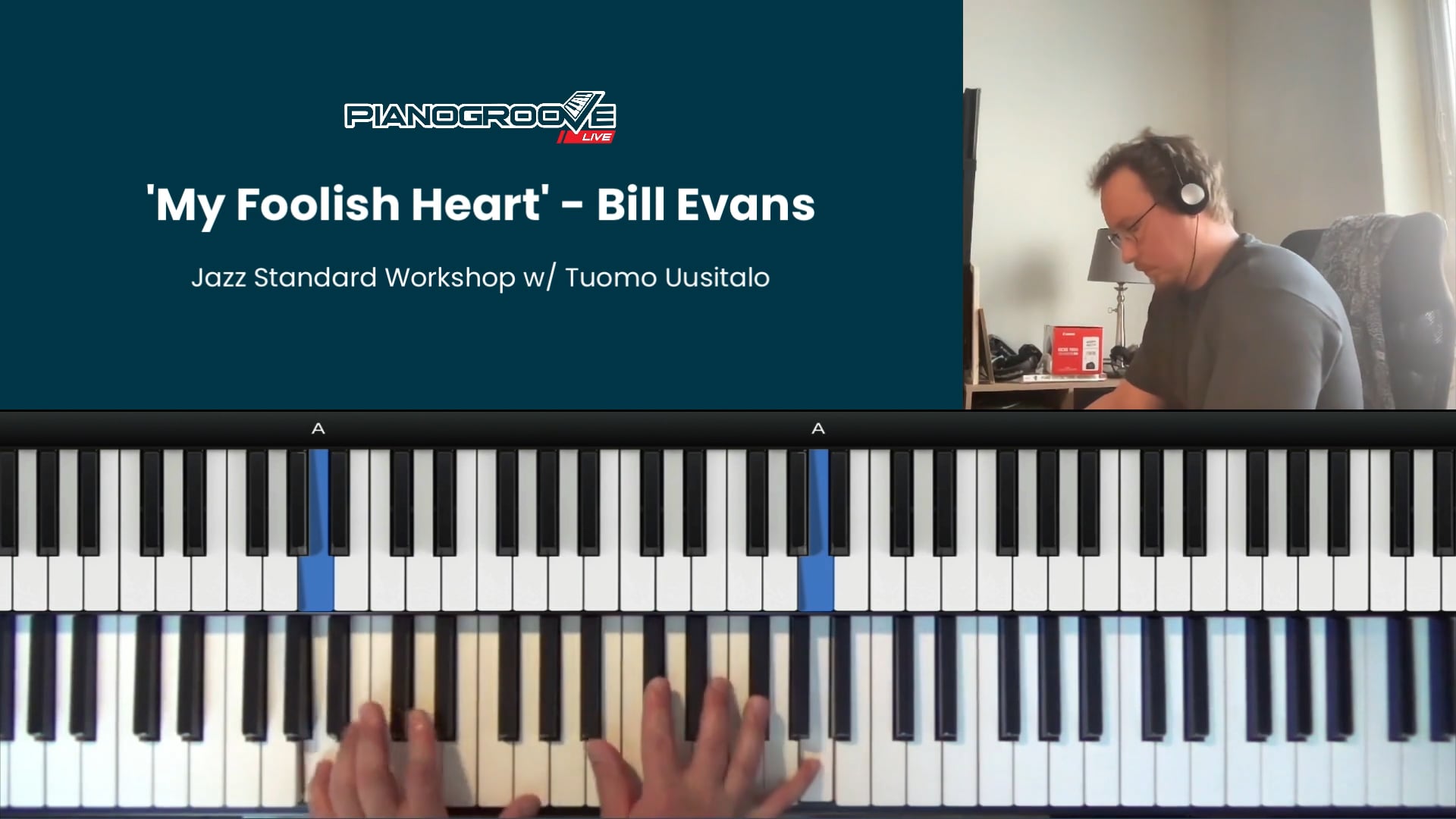

Tuomo Uusitalo
Tuomo is an award-winning pianist, composer, arranger and educator. Having released two albums as a leader, he has established himself in the New York jazz scene and continues touring internationally both as a leader as well as sideman.
Live Seminar Resources
Live Seminar Resources
PDF Downloads
- Seminar Handout
Join PianoGroove Pro to access all downloads and learning resources.
Download theory supplements, midi files, chord changes and full note-for-note transcriptions of every lesson.
- My Foolish Heart - A Major
Join PianoGroove Pro to access all downloads and learning resources.
Download theory supplements, midi files, chord changes and full note-for-note transcriptions of every lesson.
Related Lessons
Forum Threads
Seminar Description
Seminar Description
“My Foolish Heart” – Jazz Standard Workshop
Welcome to this month’s Jazz Standard Workshop, where we explore the timeless ballad “My Foolish Heart.” In this lesson, we break down the harmony of the tune, analyze different approaches to playing it, and listen to Bill Evans’ iconic interpretation from his 1961 live recording at the Village Vanguard.
By the end of this lesson, you will have a deeper understanding of the harmonic structure of “My Foolish Heart” and how to approach it in both solo and trio settings.
Understanding the Harmony of “My Foolish Heart”
The harmony of “My Foolish Heart” follows a standard tonal jazz progression with rich voice-leading possibilities. We begin by analyzing the basic 7th chord progressions in the key of Bb major, which is a common key for this tune, though Bill Evans performed it in A major.
- The A section starts with a I to IV movement without an intermediate dominant chord, which is less common in jazz standards.
- The first cadence features a II-V progression resolving to the II chord (C-7) instead of directly to the I.
- We also see secondary dominants leading to different harmonic destinations, including a II-V to the III (D-7 to G7) and a III altered dominant (D7) resolving to VI (G-7).
- The B section introduces a key harmonic shift, with a II-V leading to IV and a four minor (Eb-7 to Ab7) resolving back to the tonic.
- The C section expands on these ideas, adding chromatic passing chords and re-harmonization options for more movement.
This harmonic framework provides a foundation for arranging and improvising over the tune.
Bill Evans’ Interpretation
Bill Evans’ trio recording of “My Foolish Heart” is an essential listening experience for jazz pianists. His arrangement and improvisation reveal several key concepts that we can apply to our own playing:
Sparse Voicings & Bass Interaction
Unlike traditional jazz piano comping, Evans allows the bass player (Scott LaFaro) to outline the harmony, often keeping one chord per bar rather than frequent harmonic movement. This creates space and allows the melody to shine.
Focus on Melody
Evans maintains a strong connection to the melody throughout his improvisation, often using delicate chordal voicings and subtle reharmonizations rather than long, technical runs.
Block Chord & Thirds-Based Voicings
Evans frequently plays the melody harmonized in block chords or thirds, adding warmth and depth to his phrasing. This technique enhances the expressive nature of his interpretation.
Rhythmic Variation & Double-Time Feel
The drummer introduces a double-time feel at key moments, shifting the rhythmic energy without increasing the harmonic pace. This change in feel creates a natural build in intensity while keeping the underlying harmony intact.
Unique Outro Progression
Evans ends the tune with a 4-minor resolution (Eb-7 to Ab7) into a descending 3-6-2-5 turnaround, resolving back to the tonic in a delicate and lyrical way.
5 Practice Tips
Visualize the Form & Chord Progressions
- Identify the II-V-I movements and secondary dominants within the tune.
- Recognize the 4-minor resolution (Eb-7 to Ab7 to Bbmaj7), a common jazz harmonic device.
Use Two-Handed Voicings
- Spread chord tones between both hands for a balanced sound.
- Experiment with Bill Evans-style spread voicings, focusing on smooth voice leading.
Imitate Bill Evans’ Use of Space
- Avoid overplaying—less is more.
- Allow the melody to dictate phrasing and harmonic choices.
Explore Block Chords & Harmonic Fills
- Harmonize the melody using block chords for a fuller sound.
- Use thirds and sixths to create smooth, lyrical lines.
Experiment with Time Feel & Rhythmic Flexibility
- Try switching between ballad time and double-time feel while comping.
- Play with rhythmic placement, leaving space between phrases.
Next Steps
Take some time to listen to Bill Evans’ performance of “My Foolish Heart” and try to play along with the melody and harmony using the techniques discussed. Join the PianoGroove Forum to share your progress, ask questions, and connect with other jazz students exploring this beautiful ballad.
Happy practicing! 🎶








where are the pdf’s?
Hi Rick,
I have just added the PDF files and also links to related lessons and forum threads.
Please see the “Seminar Resources” in the bottom right hand side of this page.
Cheers,
Hayden
Why does it say video not found? I really want to study and learn how Tuomo voices this wonderful standard. Thanks 😊
Hey it’s playing great now! 🎹😃
Hi Leanne,
Thanks for letting me know about this and sorry for the tech issue. After our live seminar streams take place, the videos are temporarily stored on Vimeo until they are moved to our dedicated video hosting location.
I have just started uploading the video to our own hosting. If you are watching the video later today, you might see a notification on the screen that says “video is uploading” and a progress figure out of 100%.
Once the video is uploaded to our hosting, the playback will be much more reliable.
Thanks for your patience/understanding and I will also add the chapters and in-video notation asap.
Cheers,
Hayden